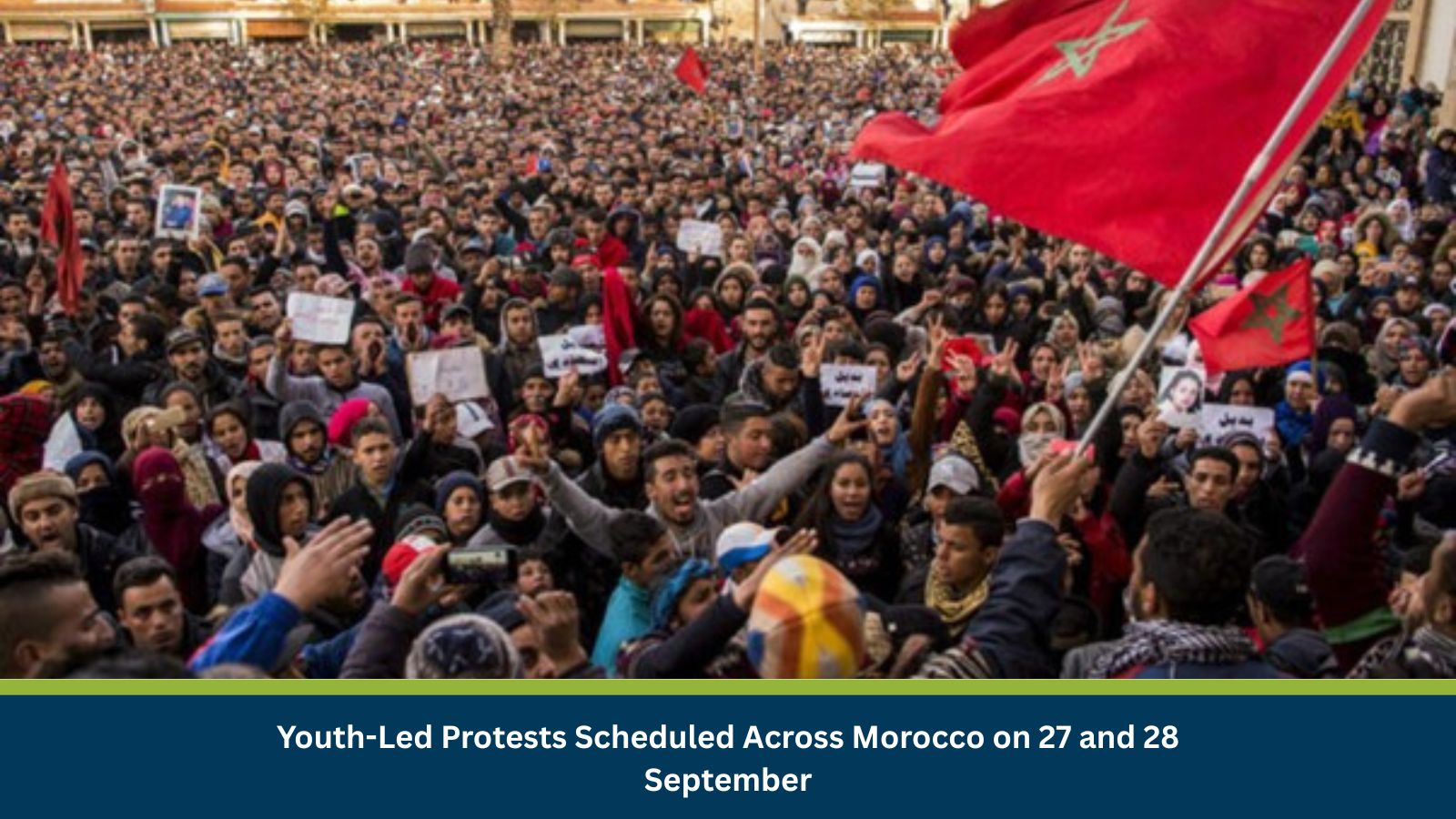What is Risk Analysis in the Context of Civil Disturbances
Risk analysis for civil disturbances examines the risks posed by organized demonstrations, particularly their potential to disrupt social order, mobility, and business continuity. Morocco has a history of socio-economic protests, ranging from labor strikes to student mobilizations, which typically remain contained but disruptive. Casablanca, in particular, has frequently been the focal point of large-scale demonstrations, with temporary road closures, arrests, and reduced business activity. Youth-led mobilizations amplify the risk due to their unpredictable turnout and the use of social media, which can rapidly escalate the scale and intensity of events. Understanding these dynamics is crucial for anticipating operational disruptions and preparing mitigation measures.
Executive Summary
- Date of Incident: 27–28 September 2025
- Location: Agadir, El Jadida, Meknes, Fez, Marrakech, Rabat, Casablanca
- Risk Category: Civil Disturbance
- Severity Score: 3/5
- Confidence Level: 80%
Nationwide, youth-led protests are scheduled for 27–28 September across Morocco’s major cities. The demonstrations are fueled by grievances against systemic socio-economic issues and have gained momentum through social media. Historical precedent suggests a moderate risk of disruption to public order and urban mobility, particularly in Casablanca and Rabat. While fatalities are unlikely, minor injuries, arrests, and clashes with police are possible. The protests are expected to last for two days, with concentrated disruptions during daylight hours and residual traffic and logistical effects extending into the evenings.
Current Updates
Youth organizations have confirmed mobilizations in major Moroccan urban centers for 27 and 28 September. The protests are being widely promoted online, and Casablanca is anticipated to be the epicenter due to its historical prominence in similar movements. Authorities are expected to deploy heightened security and may enforce temporary restrictions on gatherings. The overlap with large-scale public events, including a 10K race scheduled in Casablanca on 28 September, may exacerbate traffic congestion and resource strain for law enforcement.
Known Hotspots and Sensitive Areas
Sensitive zones for potential disruption include:
- Casablanca: Mohammed V Avenue, Place Mohammed V, United Nations Square, Court of Appeal, Spanish Consulate.
- Rabat: Parliament building and central administrative offices.
- Other Cities: Key public squares, prefecture offices, and university campuses in Marrakech, Fez, and Meknes.
These areas have historically been targeted during socio-economic protests, with localized closures and crowd dispersal operations by police.
Impact on Transportation and Services
The protests are expected to cause moderate disruption (Severity 3–4) across major urban centers. Road closures and diversions will likely affect main arteries in Casablanca and Rabat, creating prolonged traffic congestion. Public transport, including buses and trams, may face temporary suspensions or rerouting in affected districts. Urban logistics and delivery services will experience delays, particularly for last-mile movements. Businesses near protest zones will face reduced foot traffic, forced closures, or restricted access during peak demonstration hours. Utility and IT disruptions are improbable, though mobile networks could experience localized congestion in dense crowd areas.
Recommended Actions
- Workforce & Safety: Implement work-from-home arrangements or staggered shifts for staff in Casablanca, Rabat, and Marrakech. Provide employees with real-time updates on protest routes, safe commuting alternatives, and emergency contact protocols.
- Asset Security: Reinforce access points, secure windows and parking areas, and relocate high-value equipment away from protest-prone zones. Increase on-site security presence where feasible.
- Business Continuity & Logistics: Review delivery schedules and reroute logistics to avoid central districts. Establish backup warehousing and inventory provisions to counter short-term bottlenecks.
- Stakeholder Communication: Disseminate clear internal safety guidelines and proactively inform clients and partners about potential delays. Appoint a spokesperson to manage external communications and media inquiries.
Multidimensional Impact
The protests will have a multi-layered impact across Moroccan cities. People safety risks are moderate, with likely reports of minor clashes, arrests, and occasional injuries during police crowd-control efforts. Social cohesion may be strained as youth mobilizations amplify grievances, potentially leading to follow-up demonstrations or counter-mobilizations. Business continuity will be affected in urban centers, with reduced retail and service activity near protest zones, while last-mile delivery and freight logistics may encounter temporary bottlenecks. From a regulatory standpoint, arrests for public order offenses are probable, though systemic policy shifts are unlikely from this single event. Reputationally, Morocco’s urban hubs may experience temporary negative media attention, with implications for investor and tourist perceptions. Environmental consequences will likely be limited to increased litter and cleanup needs in central squares, and while utilities are not expected to be directly damaged, congestion and overlapping events such as the Casablanca 10K race will intensify strain on urban infrastructure and public resources.
Emergency Contacts
- Police: 190
- Fire Department: 150
- Ambulance: 150
- National Emergency: 190 or 150
- Ministry of Interior, Morocco: Website
- Government of Morocco (General Information): Website
- News Updates: Morocco World News (frequent first reports)
Final Thoughts
The youth-led protests of 27–28 September represent a moderate but widespread civil disturbance risk across Morocco’s major cities. While large-scale violence is unlikely, disruptions to traffic, urban mobility, and business activity are inevitable, particularly in Casablanca and Rabat. The coincidence with major public events such as the Casablanca 10K adds complexity to urban management during this period. The strategic takeaway is that businesses and policymakers should anticipate localized operational challenges, adopt proactive continuity planning, and prioritize employee and asset security. Stay ahead of operational risks with real-time alerts, scenario modeling, and expert advisories with datasurfr’s Predict. Start your 14-day free trial of Datasurfr’s Risk Intelligence Platform today.






